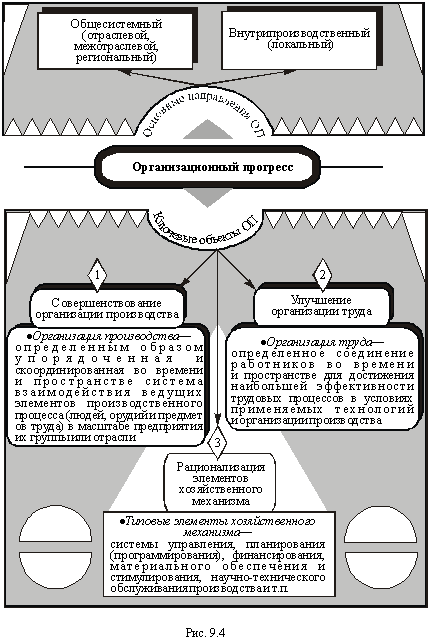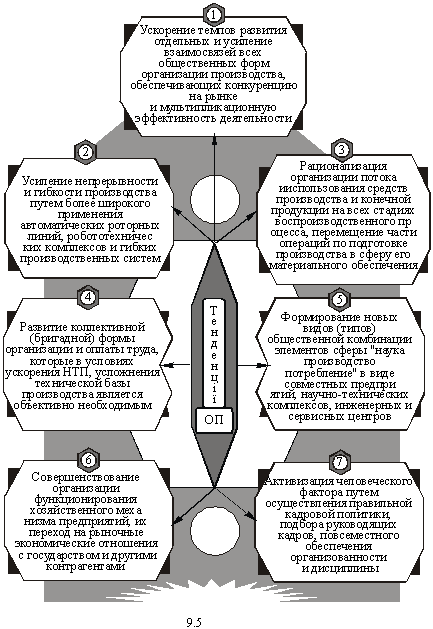home
 Economy Economy
 Economy of the enterprise - Pokropivny SF Economy of the enterprise - Pokropivny SF
|
Economy of the enterprise - Pokropivny SF
9.3. Organizational progress
Concept, directions and objects. Different directions of scientific and technical progress give rise to concrete economic and social consequences, the depth and effectiveness of which largely depend on the measure of the perfection of the organization of production and labor, the entire system of management. In this regard, the high level of organization of people's activities, based on the achievement of their goals primarily on a powerful scientific and technical potential, is gaining importance in modern conditions.
Organizational progress ( OS ) is a generalized characteristic of the process of using organizational factors of development and increasing the efficiency of production. Its essence consists in improving existing and applying new methods and forms of organizing production and labor, elements of the economic mechanism in all parts of economic management.
Organizational progress inherent in certain features that distinguish it from scientific and technological progress.
- First, NTP is a direct and main factor in the growth of labor productivity and production efficiency, and organizational progress creates the conditions for the practical application of potential technological opportunities for the intensification of industrial and labor processes created by NTP.
- Secondly, the creation and implementation of new technology and technology, the use of new structural materials and the development of new products lead to a reduction in the labor intensity of their manufacture, and improving the organization of production and labor can reduce the loss of working time and downtime of equipment.
- Thirdly, the practical implementation of certain directions of scientific and technical progress is constantly associated with the large expenditures of social labor, material and financial resources; The implementation of the same organizational measures in many cases does not require new costs (at least additional resources).
Among the organizational factors of the development of the economy of the branches of the national economy, the main role is played by the organization of production -a system of interaction of the basic elements of the production process, that is, ordered and coordinated in time and space, that is, people (workers), tools and objects of labor; It covers all the links of production (from a workplace in a separate enterprise to a group of enterprises of one or different branches of the production sphere). In connection with this, it is customary to distinguish between local (isolated) and social forms of production organization. If local forms of organization appear as a result of a single division of labor and encompass the division and integration of production processes within the enterprise, its individual shops and sectors, then the social forms arise and develop as a consequence of the general and partial division of labor. They include: the concentration and deconcentration of industries, the optimization of production sizes within the industry; Specialization and co-operation of enterprises of one or several branches of the national economy, the conversion of production; Combining diversified production, diversification of enterprises; Location (territorial organization) of the enterprise.
An integral part of the organization of production is the organization of labor , which determines the technology of integrating individual workers and the combined labor force, the aggregate living labor capable of producing material goods and spiritual values. Under the organization of labor, it is customary to understand a certain combination of workers in time and space in order to achieve the greatest efficiency of labor processes in conditions of specifically applied technologies and organization of production. The connection of the sections of the labor process in time is provided by various forms of division and cooperation of labor, the organization of servicing of workplaces, and the establishment of rational labor regimes. The spatial association of workers in production is embodied in various forms of building brigades and other production links in production, securing staff for the corresponding jobs, etc.
Organizational progress can be attributed not only to the improvement of the processes of labor production, but also the functioning of individual or all the aggregate elements of the economic mechanism - management systems, planning (programming), financing, and maintenance of production. The constant rationalization of the management system is an important prerequisite for improving the work activity of the staff, a means of combining scientific, technical and organizational progress as the most important factors in increasing the efficiency of production through its all-out intensification.
Depending on the place of adoption and implementation of organizational decisions, the scale of their influence on the intermediate and final results of people's activities, two areas of organizational progress can be identified: system- wide and in- house , each of which covers key objects at appropriate levels of the economy (see Figure 9.4).
Carried out on a public scale, but at different levels (associations, enterprises, factories, industries, regions, the national economy as a whole), social organizational progress is decisive. It is he who sets the benchmarks for the development and adoption of numerous highly effective organizational solutions of an in-house nature. In turn, the local organizational progress at enterprises corresponds to an increase in the organizational level of the activity of specific production and economic systems.
Modern tendencies. Under the influence of NTP, in the context of the realized need to solve large-scale tasks of transferring the economy to market relations and an intensive development path, significant (often radical) organizational transformations take place not only directly in the sphere of production, but also in the entire system of its servicing and management. To ensure effective management of organizational progress, it is important to timely identify and correctly assess its trends, progressive and undesirable changes in the forms of organization of production and labor, and the functioning of individual elements of the economic mechanism. The main current trends in organizational progress are shown in Fig. 9.5.


The development and deepening of the identified trends in the organization of production and labor processes and the functioning of the economic mechanism must be considered modern tasks of accelerating organizational progress. Priority should be given to measures to implement the organizational and economic management and further mutually agreed development of public forms of production organization. Only a set of measures of this orientation can ensure the implementation of identified reserves of acceleration and increase the effectiveness of organizational progress.


Comments
When commenting on, remember that the content and tone of your message can hurt the feelings of real people, show respect and tolerance to your interlocutors even if you do not share their opinion, your behavior in the conditions of freedom of expression and anonymity provided by the Internet, changes Not only virtual, but also the real world. All comments are hidden from the index, spam is controlled.